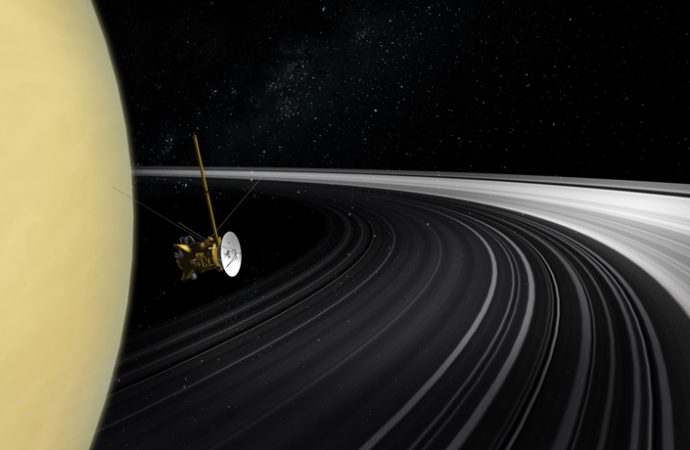A new analysis of Cassini data could shed light on the origins of the massive belts
The “ring rain” of material falling from Saturn’s rings into the planet’s atmosphere is a much more intense, contaminated downpour than scientists thought.
For decades, astronomers have suspected that Saturn’s rings pelt the planet with grains of water ice, but some of the final observations from NASA’s Cassini spacecraft provide the first detailed views of these celestial showers. Ring rain is highly contaminated with organic matter and other molecules, and hammers Saturn at thousands of kilograms per second, researchers report in the Oct. 5 Science. Understanding the rain’s surprising quantity and quality could help clarify the origins and evolution of Saturn’s rings.
Researchers analyzed data collected by Cassini’s Ion Neutral Mass Spectrometer during the spacecraft’s final few orbits in 2017, as it sailed through the gap between Saturn and its innermost ring, known as the D ring. Water constituted only about 24 percent of the material tumbling from Saturn’s ring system into its atmosphere; the rest was methane, carbon monoxide, dinitrogen, ammonia, carbon dioxide and fragments of organic nanoparticles.
The ring rain’s diverse chemical composition “was a big surprise,” because remote observations show that Saturn’s ring system, on the whole, is almost entirely water ice, says Cassini project scientist Linda Spilker of NASA’s Jet Propulsion Laboratory in Pasadena, Calif., who wasn’t involved in the study. Researchers aren’t sure why ring rain is so deprived of water.
Cocktail conundrum
The ring rain that Cassini’s Ion Neutral Mass Spectrometer caught falling from Saturn’s rings into its atmosphere is only about 24 percent water — a major surprise, given that Saturn’s ring system is almost entirely water ice. The rest of the ring rain is composed of organic material and other molecules.
The chemical breakdown of Saturn’s ring rain

A belt of radiation tucked inside Saturn’s rings could be responsible, says study coauthor Jeff Cuzzi, a planetary scientist at NASA’s Ames Research Center in Moffett Field, Calif. Cassini’s end-of-life observations also provided the first closeup views of this band of energetic protons, described in another study in the Oct. 5 Science. The belt’s high-energy radiation may have blasted away much of the water in the D ring very close to Saturn, leaving behind heavier materials like organic compounds, Cuzzi speculates.
Whatever its cause, the ring rain’s peculiar composition may reshape our understanding of the carbon and nitrogen content of Saturn’s atmosphere, says Hunter Waite, a planetary scientist at the Southwest Research Institute in San Antonio and a coauthor of the ring rain study. Saturn’s presumed chemical makeup may be “just a veneer” created by falling material masking the gas giant’s true composition, he says.
In addition to the ring rain’s chemistry, the Cassini observations also revealed how quickly this material is falling into Saturn’s atmosphere: between 4,800 and 45,000 kilograms per second.
I spy
Observations from Cassini’s final few months revealed a radiation belt composed of high-energy protons tucked inside the gas giant’s ring system. This belt (bright colors below) passes through Saturn’s thin, innermost D ring, and might be stripping water out of the ring material closest to Saturn.

“It’s just an enormous amount of mass flowing into the planet,” Cuzzi says.
Saturn’s rings probably haven’t sustained this rate of rainfall over the course of the planet’s history, he says. If that were the case, the spindly little D ring would have long since eroded away. But a comet or other rogue object may have hit Saturn’s ring system recently, jostling grains out of their usual orbit and making them more vulnerable to Saturn’s gravitational pull.
But if the current deluge is, in fact, Saturn’s normal rate of ring rain, then perhaps the D ring continually siphons material from Saturn’s outer rings, says Kelly Miller, a cosmochemist at the Southwest Research Institute and a coauthor on the ring rain study.
The exact nature of Saturn’s relationship to its rings “is still a puzzle,” Spilker says. But devising more detailed theoretical simulations of what’s going on between the planet’s atmosphere and rings, and testing these theories against the trove of data collected by Cassini could help fill in the picture.
Such work may help scientists better understand not only Saturn, but also any ring-bearing planets that might circle other stars in the universe, she says.
Source: Science News

































Leave a Comment
You must be logged in to post a comment.